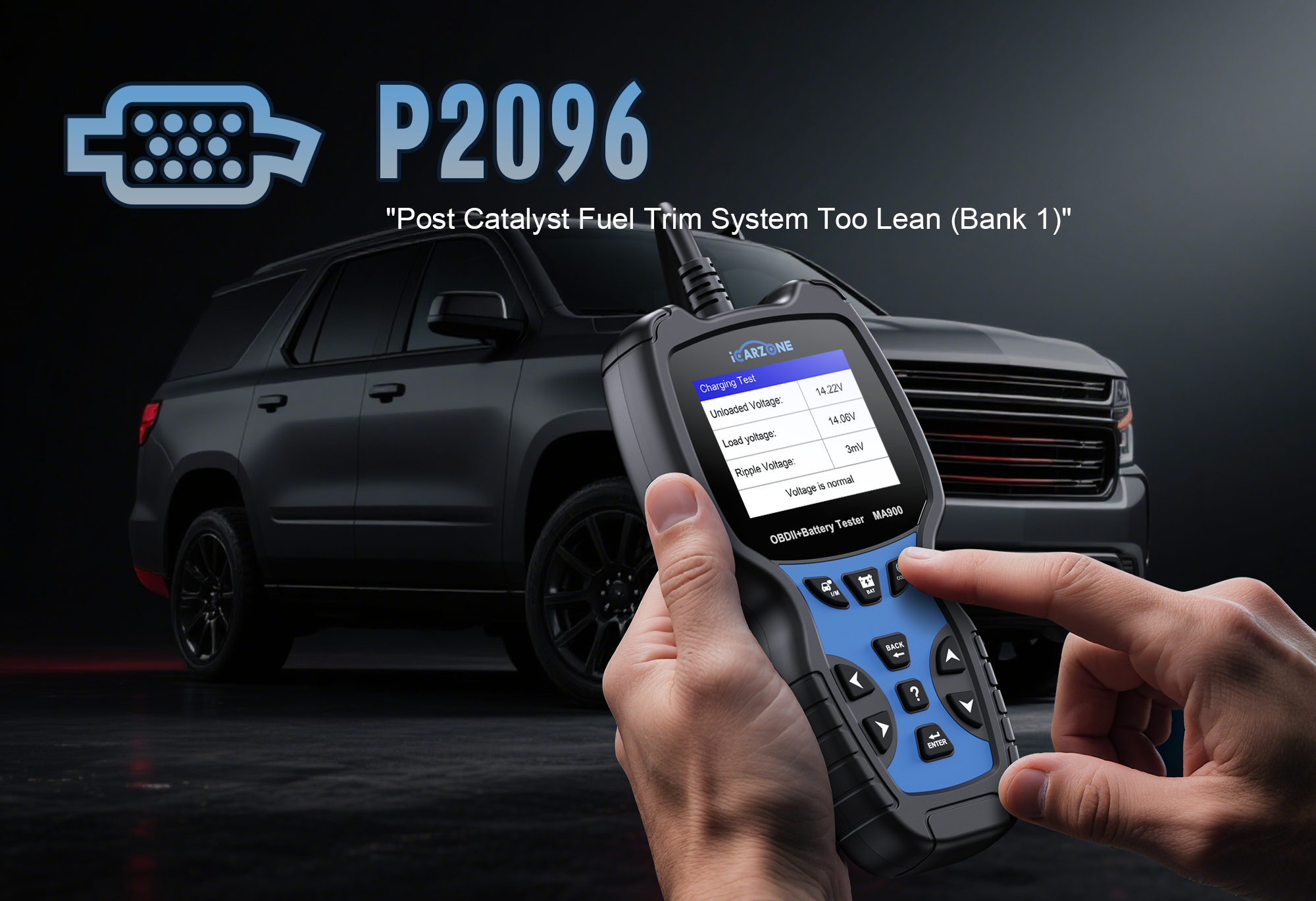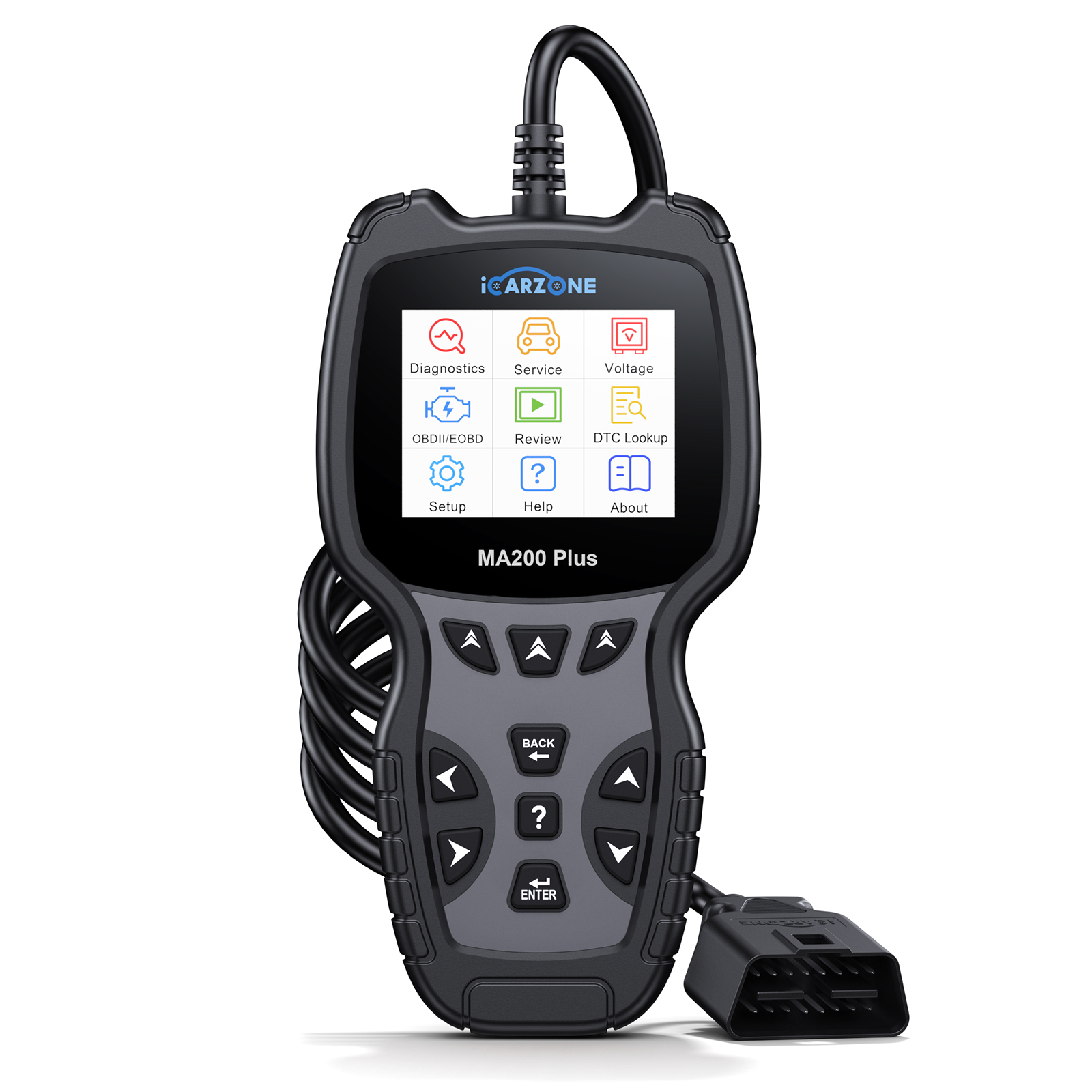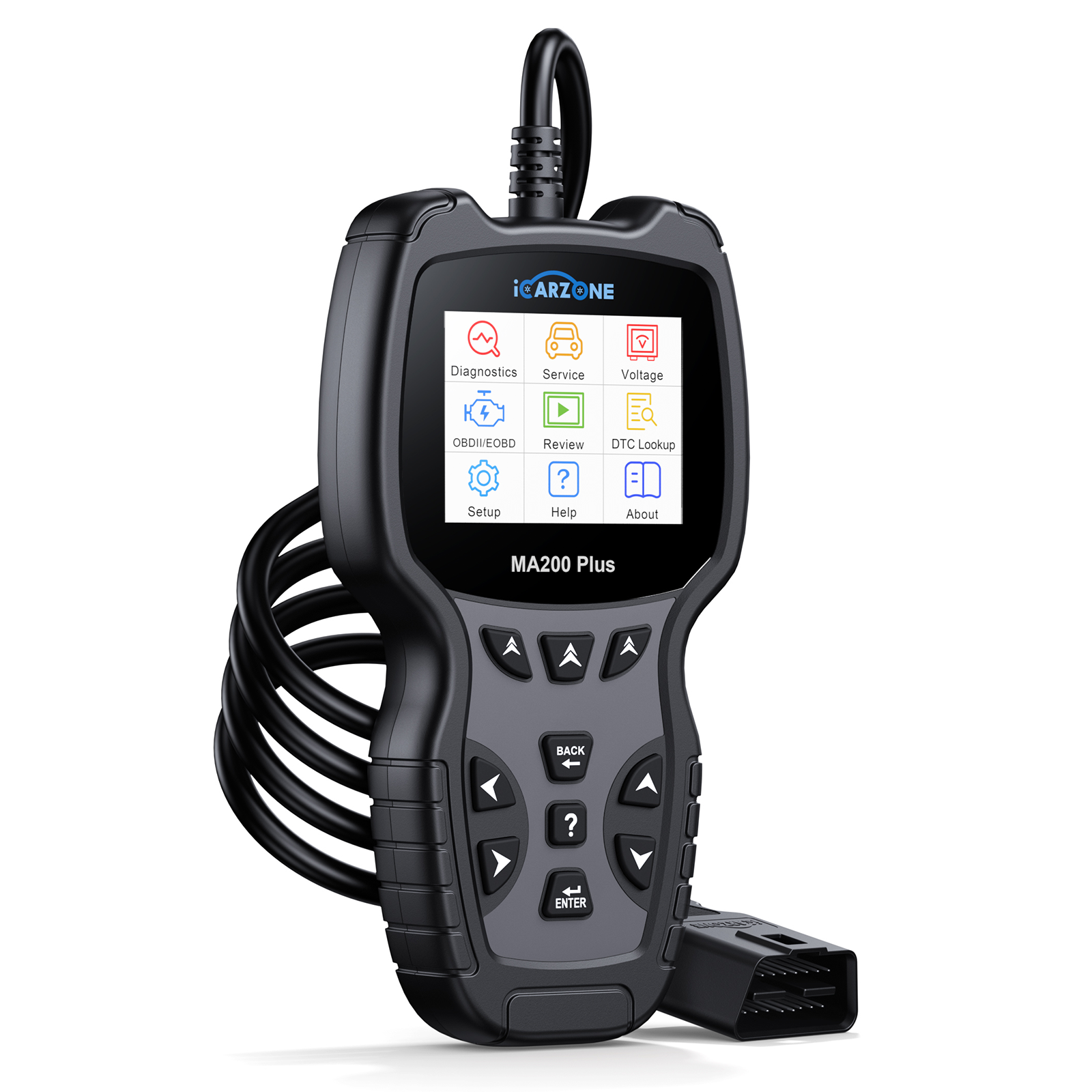P2096 Chevrolet Silverado 1500 Guide: Post-Cat Rich Fixes & MA900 Diagnosis

P2096: Post-Catalyst Fuel Trim Rich (Bank 1)
Resolve P2096 in Chevrolet Silverado 1500. Learn causes, symptoms, and fixes for post-catalyst rich fuel trim issues using the MA900 diagnostic tool.
Get MA900 Now1. What is P2096?
P2096 is a Diagnostic Trouble Code that indicates Post-Catalyst Fuel Trim System Rich (Bank 1). Bank 1 refers to the engine bank containing cylinder 1, and "post-catalyst" means the issue relates to fuel trim readings after the catalytic converter. The engine control module (ECM) uses upstream and downstream oxygen sensors to adjust fuel delivery (fuel trim). P2096 triggers when the ECM detects the post-catalyst fuel trim is consistently "rich"—meaning there’s too much unburned fuel in the exhaust after passing through the converter—for a specified time.
Why It Matters for Chevrolet Silverado 1500
A persistently rich post-catalyst condition can damage the catalytic converter over time, as unburned fuel ignites inside the catalyst. For Silverado owners, this means potential converter failure (costing $800–$2,500 to replace) and increased fuel consumption. P2096 also often indicates underlying issues with fuel delivery or oxygen sensor performance that affect towing capability and engine efficiency.
2. Common Causes in Chevrolet Silverado 1500
P2096 in Silverado 1500 typically stems from issues disrupting the balance between air and fuel after combustion. Common causes include:
- Faulty downstream oxygen sensor (Bank 1 Sensor 2) — A slow or unresponsive post-cat O₂ sensor provides inaccurate data to the ECM, leading to incorrect fuel trim adjustments.
- Clogged or failing catalytic converter — A restricted converter can trap unburned fuel, causing rich readings downstream.
- Leaking fuel injectors — Faulty injectors on Bank 1 can introduce excess fuel into the combustion chamber, leading to rich exhaust.
- Mass Air Flow (MAF) sensor contamination — A dirty MAF sensor under-reports air intake, tricking the ECM into adding more fuel.
- Exhaust leaks upstream of downstream sensor — Unmetered air entering the exhaust can cause false rich readings.
- PCV system issues — A stuck PCV valve can introduce excess oil vapor, altering fuel trim calculations.
3. Key Symptoms in Chevrolet Silverado 1500
Owners typically notice these P2096-related symptoms:
- Illuminated Check Engine Light with P2096 stored
- Decreased fuel economy (1–3 MPG drop common)
- Strong fuel odor from exhaust (unburned fuel)
- Reduced engine performance, especially during acceleration
- Catalytic converter overheating (may trigger P0420 later)
- Occasional rough idle or hesitation under load
Pro tip: Incorporate phrases like "Silverado 1500 post-catalyst fuel trim rich symptoms" in content to match user search patterns.
4. Silverado 1500 Models Prone to P2096
While P2096 can occur across model years, certain Silverado variants show higher incidence due to engine design and sensor placement:
- 2014–2019 Silverado 1500 with 5.3L EcoTec3 V8 — Most reported cases due to specific O₂ sensor calibration
- 2017–2023 Silverado 1500 6.2L V8 — Higher fuel pressure systems increase injector-related P2096 risks
- High-mileage Silverados (100,000+ miles) — Sensor degradation and converter wear become more common
- Silverados used for frequent short trips — Incomplete catalyst heating accelerates sensor fouling
Technical Service Bulletins (TSBs) for 2016-2018 models recommend O₂ sensor replacement with updated part #12677834 for P2096 resolution.
5. Diagnostic Steps with MA900
The MA900 diagnostic tool simplifies P2096 diagnosis by monitoring fuel trim values and sensor performance in real time:
| Step | Action with MA900 | Silverado Goal | Pass/Fail Criteria |
|---|---|---|---|
| 1 | Full System Scan > Chevrolet > Silverado 1500 > Engine | Confirm P2096 and check for related codes (P0172, P0420, P0137) | Pass: Isolated P2096 | Fail: Multiple fuel system codes indicate broader issues |
| 2 | Live Data > Monitor "Short Term Fuel Trim (STFT)" and "Long Term Fuel Trim (LTFT)" for Bank 1 (post-cat) | Normal post-cat fuel trim should stay within ±10% at steady speeds | Pass: Trim values within range | Fail: Consistent negative values (-10% or lower) indicate rich condition |
| 3 | Live Data > Compare upstream vs. downstream O₂ sensor voltage (Bank 1) | Downstream voltage should mirror upstream but with reduced amplitude | Pass: Downstream switches slowly (0.1–0.9V) | Fail: Flat or erratic downstream readings indicate sensor issues |
| 4 | Active Tests > "Oxygen Sensor Response Test" (Bank 1 Sensor 2) | Verify sensor can respond to rich/lean changes | Pass: Voltage changes with fuel trim adjustments | Fail: Unresponsive sensor needs replacement |
| 5 | Data Logging > Record fuel trim values during 15-minute drive cycle | Identify conditions (idle, acceleration, cruise) where rich condition occurs | Pass: Trim stabilizes during driving | Fail: Persistent rich condition across all scenarios |
Case Example: A 2018 Silverado 5.3L with P2096 showed post-cat fuel trim at -15% (rich) via MA900. Upstream O₂ sensor readings were normal, but downstream sensor voltage was flat. After replacing the downstream sensor (OEM #12677834) and clearing codes, MA900 confirmed fuel trim returned to +2% (normal), resolving P2096.
Diagnose Silverado P2096 with MA9006. Fixes & Execution for Chevrolet Silverado 1500
Repair strategy depends on MA900 test results. Most P2096 cases resolve with these solutions:
- Replace downstream O₂ sensor (Bank 1 Sensor 2) — If MA900 confirms unresponsive or slow sensor. Use OEM-equivalent (AC Delco #12677834 for 2014-2019 5.3L).
- Clean or replace MAF sensor — Contaminated MAF sensors are a common cause in Silverados; use MAF cleaner spray for mild cases.
- Inspect and repair fuel injectors — Leaking injectors on Bank 1 require replacement (common in 6.2L models with 100k+ miles).
- Repair exhaust leaks — Seal leaks between manifold and downstream sensor with new gaskets or patches.
- Catalytic converter service — If MA900 data shows converter restriction, replacement may be necessary (last resort due to cost).
- ECM reflash — Some 2016-2018 models benefit from updated calibration to resolve false P2096 triggers.
Silverado-Specific Repair Tips
- Always address P2096 promptly to prevent catalytic converter damage
- Use MA900 to verify repair success by monitoring fuel trim during test drive
- When replacing O₂ sensors, apply anti-seize compound to threads (avoid sensor element)
- Clean MAF sensor first before replacing (often resolves P2096 in dusty environments)
- After repairs, perform 30-minute drive cycle to allow ECM to relearn fuel trim values.
7. Repair Costs & Safety Tips for Silverado 1500
Critical Safety Precautions
- Work on exhaust components only when completely cool to prevent burns
- Disconnect battery before replacing sensors or electrical components
- Use proper jack stands when accessing undercarriage components
- Wear eye protection when cleaning MAF sensor or working with fuel system
- Clear codes and verify fuel trim normalization with MA900 before extended driving
8. Preventive Maintenance for Silverado 1500 P2096
Reduce P2096 risk with these proactive steps:
- Replace air filter every 15,000–30,000 miles to prevent MAF sensor contamination
- Use Top Tier detergent gasoline to minimize injector deposits
- Inspect O₂ sensor wiring during routine service—protect from heat and damage
- Perform annual fuel system cleaning (including injectors) on 80,000+ mile trucks
- Use MA900 to monitor fuel trim values quarterly on high-mileage Silverados
- Avoid short trips when possible—allow catalyst to reach operating temperature
For Silverados used for towing, consider more frequent maintenance intervals (every 10,000 miles) to prevent fuel system issues that trigger P2096.
9. Frequently Asked Questions
Short-term driving is possible, but prolonged operation risks catalytic converter damage. Use MA900 to assess severity before deciding.
Often yes—approximately 60% of P2096 cases in Silverados are sensor-related. Always test with MA900 first to confirm.
P0172 indicates rich condition before the catalyst (upstream), while P2096 specifically refers to post-catalyst rich readings on Bank 1.
Yes—rich fuel conditions typically cause failed emissions tests due to high hydrocarbon levels. Repair before testing.
Yes—poor quality fuel can cause injector fouling and sensor issues. Switching to Top Tier gasoline often helps.
Yes—MA900 provides real-time fuel trim data and sensor response tests, critical for accurately diagnosing P2096 root causes.
10. Summary
P2096 (Post-Catalyst Fuel Trim System Rich, Bank 1) in Chevrolet Silverado 1500 indicates excess unburned fuel in the exhaust after the catalytic converter. Left unaddressed, it can damage the converter and reduce fuel economy—especially problematic for trucks used for towing.
The MA900 diagnostic tool simplifies diagnosis by monitoring fuel trim values and O₂ sensor performance, eliminating guesswork. Most cases resolve with downstream O₂ sensor replacement, MAF sensor cleaning, or exhaust leak repair. Prompt attention to P2096 preserves catalytic converter life and maintains engine efficiency.
Fix P2096 with MA900
MA900 provides the fuel trim data and sensor tests needed to accurately diagnose P2096 in your Silverado 1500—avoid costly converter damage and unnecessary parts replacement.
Order MA900 TodayReplace example image URLs with your actual Shopify asset links for consistency. Contact us for help with model-specific adjustments to this guide.









